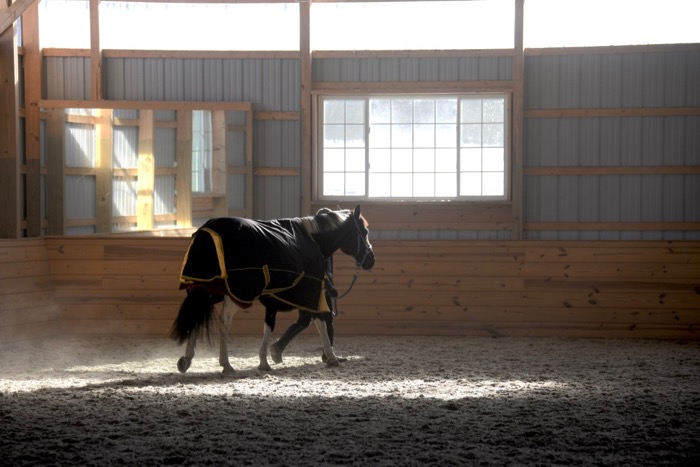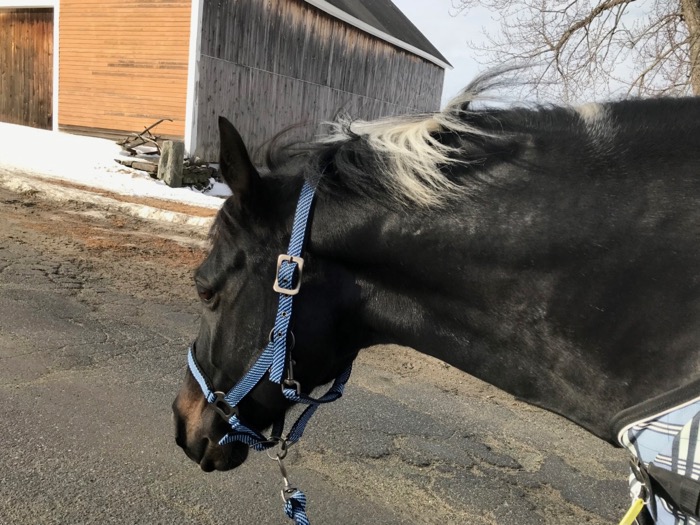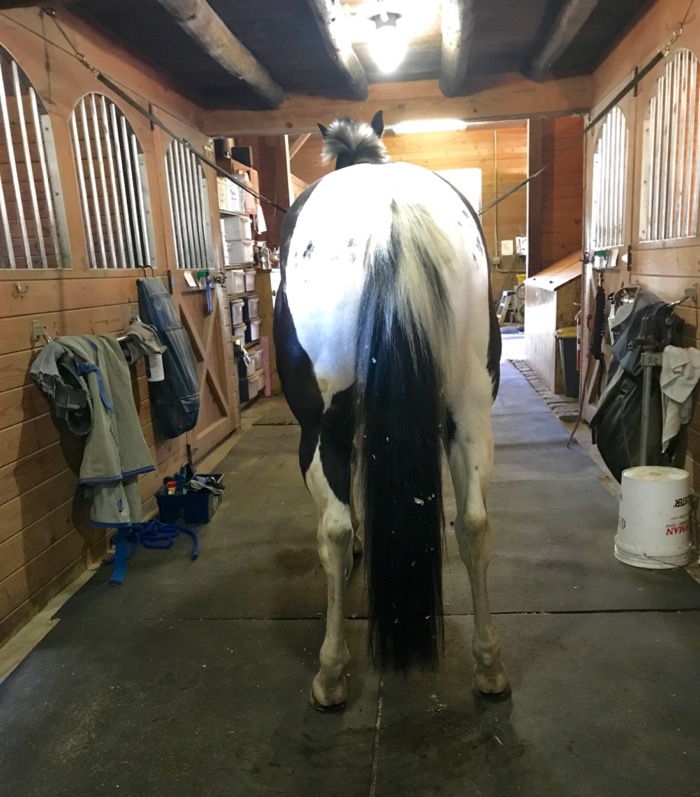Tonka and I have been going for walks.

The walking is in addition to riding. Although Tonka is turned out during the day, he doesn’t move much. Not in the snow. Not when hay is right at his feet.

A horse is designed to eat and move. Bite. Step. Repeat. In the course of a day, a horse in a natural wide-open plains environment might walk a dozen or more miles. In comparison, our stabled horses are couch potatoes.
Riding in an arena isn’t a replacement for walking. An hour in the saddle might cover 3 miles (I keep track of this with an app.) Right now, I am gradually easing Tonka back into under-saddle work, so at best we’re traveling only 2 miles daily.
I could lunge him, but I don’t want Tonka to repeatedly circle. That could strain his recovering sacroiliac joint.
So we walk. The field is deep in snow, the roads have been too icy, and the strong winds too brutally cold, to walk outside, but this week we’re experiencing the January thaw, so out we went! It’s especially good physical therapy for Tonka to walk up and down hills.
Look at his face. One ear is on me, and there’s an expression that says, This is work!

I take pride and pleasure in the fact that I have a bold horse, that I can ride alone on trails. But that’s not all temperament. It’s also training, and that training can deteriorate. The less we do, the more constrained our space, the less brave he gets. So, it was very good to walk down the road, past another farm with horses, and flags blowing in the wind, and trucks rattling by.

Although I sometimes do clicker training, and sometimes I train with food, this walk was not one of those times. Other people handle Tonka. He needs to be able to be led without the expectation of a food reward. That’s okay. There are other things about walking down the road that I can use to reinforce his good behavior. Getting out and about is intrinsically enjoyable for him. Horses are curious animals that are primed to explore their world. Also, hanging out with me is rewarding (horses do value being with friends.) If something worries Tonka (he’s not fond of mailboxes) I let him look, then, when there is that first moment of relaxation, I pet him and tell him how brilliant a horse he is. A pat on the neck means nothing to the horse unless it is paired with other, good things. In fact, a pat could just as easily be seen as an unwelcome slap. I’ve conditioned Tonka to associate a pat with a myriad of things that he likes – carrots, scratches in just the right place, permission to graze, or a rest from work. (Side note: petting your horse when riding him is not rewarding because of the pat per se. That slap, slap, slap and saying good boy is not actually pleasurable for a horse. But, the horse comes to associate a pat with a release of rein tension and rider pressure, thus it becomes a conditioned reinforcer. Rewards when riding will have to be another post!)
If there is something truly scary, I can use a behavior that I trained – the touch – which almost always replaces fear with confidence. For that, I do have cookies in my pocket. But since feeding him is rewarding to me, (that happy munching of a horse!) I restrain myself from using it unless absolutely necessary, or I would do it all the time! A walk down the road is not a training session. It’s just a walk down the road. If Tonka thinks we’re in a training session, he’s “on” and it will not be a relaxed amble. Going on an undemanding meander is good both physically and mentally for your horse. Of course, even when the walking seems boring, I’m interacting with Tonka, and everything we do has consequences, and affects what happens next, so in that sense training is always happening. But that’s not the same thing as a training session, with my expectation of attentive engagement, and my horse’s expectation of food rewards for his behavior.
I have noticed that all of this undemanding walking is good for Tonka’s mind. He settles right right into a content, relaxed place. All of this walking is having a positive effect on his physical rehab, too.
This is how Tonka stood, back in October, before the sacroiliac joint treatment. Notice the braced, wide stance behind.

Here he is, this week.

I like to think that with all of this walking, that I’m getting fitter, too. Maybe, maybe not. But I am enjoying this companionable time with my horse.


Terry, have you ever considered training Tonka to drive? Many years ago, I rode a warmblood that was exciting but exhausting. He was a bit of a powder keg at all times; shied at too many things, overreacted to even the slightest touch on his sides with one’s leg, etc. Even young and dumb(er), I believed that this anxiety was likely human-caused and I tried hard to have very quiet legs and hands and be very predictable in my movements and what I asked of him, and how. I also tried to ride with quiet confidence, to support him. I probably weighed about 120 then. Even so, while he was so impressive in the show ring, he really wasn’t much fun to ride out if it; one could never truly relax, and I endured some crazy falls from his explosive shying and small but dangerous bolts. Many months later, I saw him being worked in an indoor and being ridden by quite a large man. He was at least 250-260 lbs. The horse was 17 hh, and big, so he could handle the weight. But I was amazed at how calm the horse was under this large (and rather floppy) rider. I came to understand that the man’s weight was actually somewhat reassuring to the horse– he found it physically supportive. I’m not explaining it well, but the trainer also mentioned that they had started him driving and he was brilliant at it. Apparently the combination of the blinders and the harness and carriage frame combined with the steady forward movement also made the horse feel quite secure. I know you manage Tonka very well, but I wonder if his back issues become chronic if this might not be a fun option for you two. Uses completely different muscles and puts almost no strain on the spine– all haunches and topline muscles. I’ve schooled two horses to drive but not alone; I had a very good coach every step of the way. It’s a blast. (And the gear! Oh, the gear!)
I’ve just never been interested in driving. I’ve ridden in a few carts, and I found it uncomfortable and wanted to be on the horse 🙂 I have thoroughly enjoyed sleigh rides, though! I also don’t live in the right place. Maybe if I lived on a long dirt road in Maine…
Love your thoughts on using food vs letting the walk be relaxing and rewarding enough. I very much look forward to hearing more about riding and rewards!
After losing my little Andalusian mare a couple of months ago, I am now only working with horses that are also handled by other people. While I would love to completely convert to positive reinforcement training, it isn’t entirely practical. I’d love to hear any more thoughts you have on the crossover/compromise between traditional horsemanship and positive reinforcement training.
Thanks again for taking the time to write your lovely blog!
I’m sorry to hear about the loss of your horse. Thanks for the input. I’ll definitely write more on this topic.
You two have such an amazing relationship and brilliant communication.
It’s still a work in progress. But aren’t all relationships? 🙂